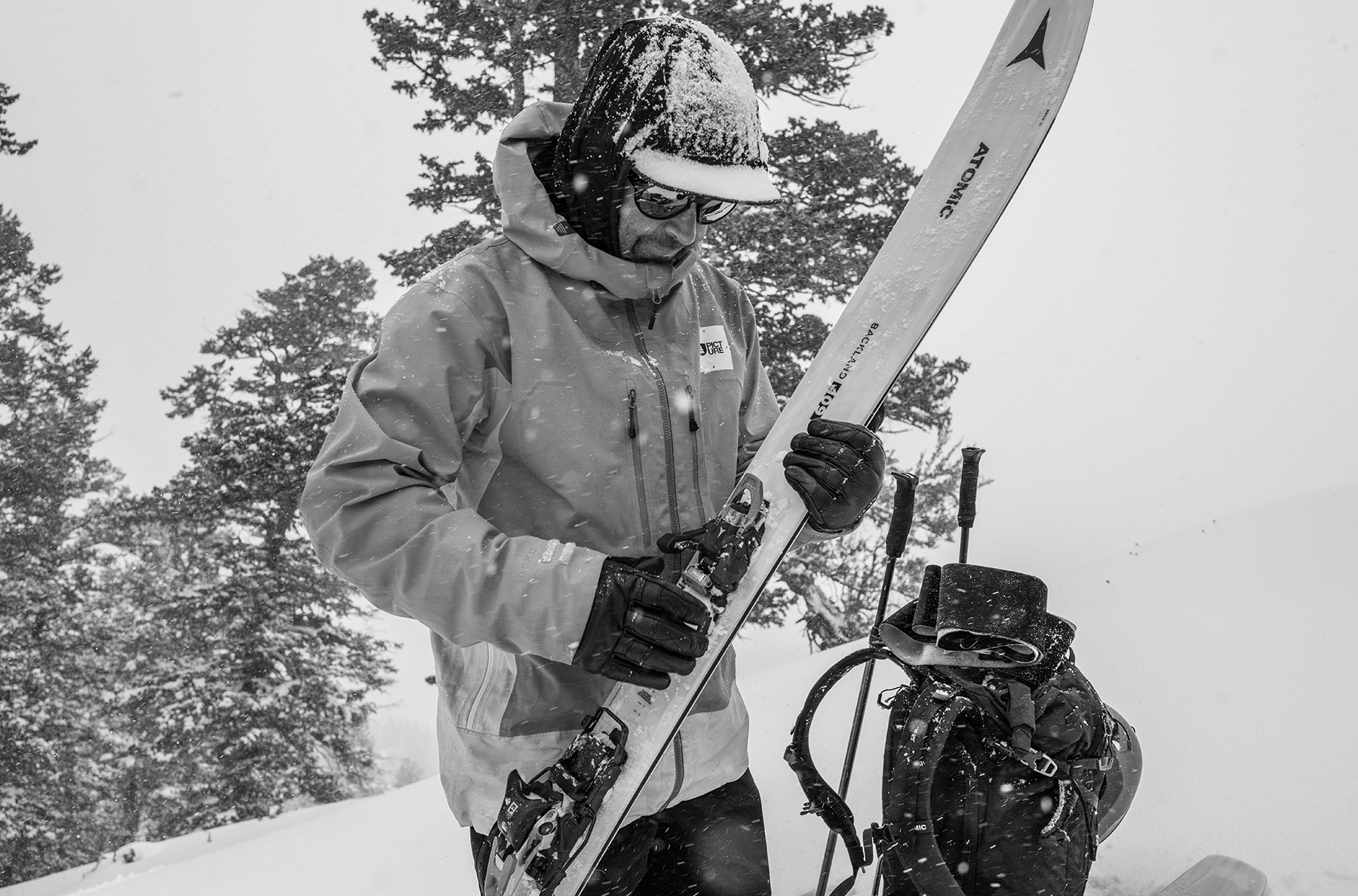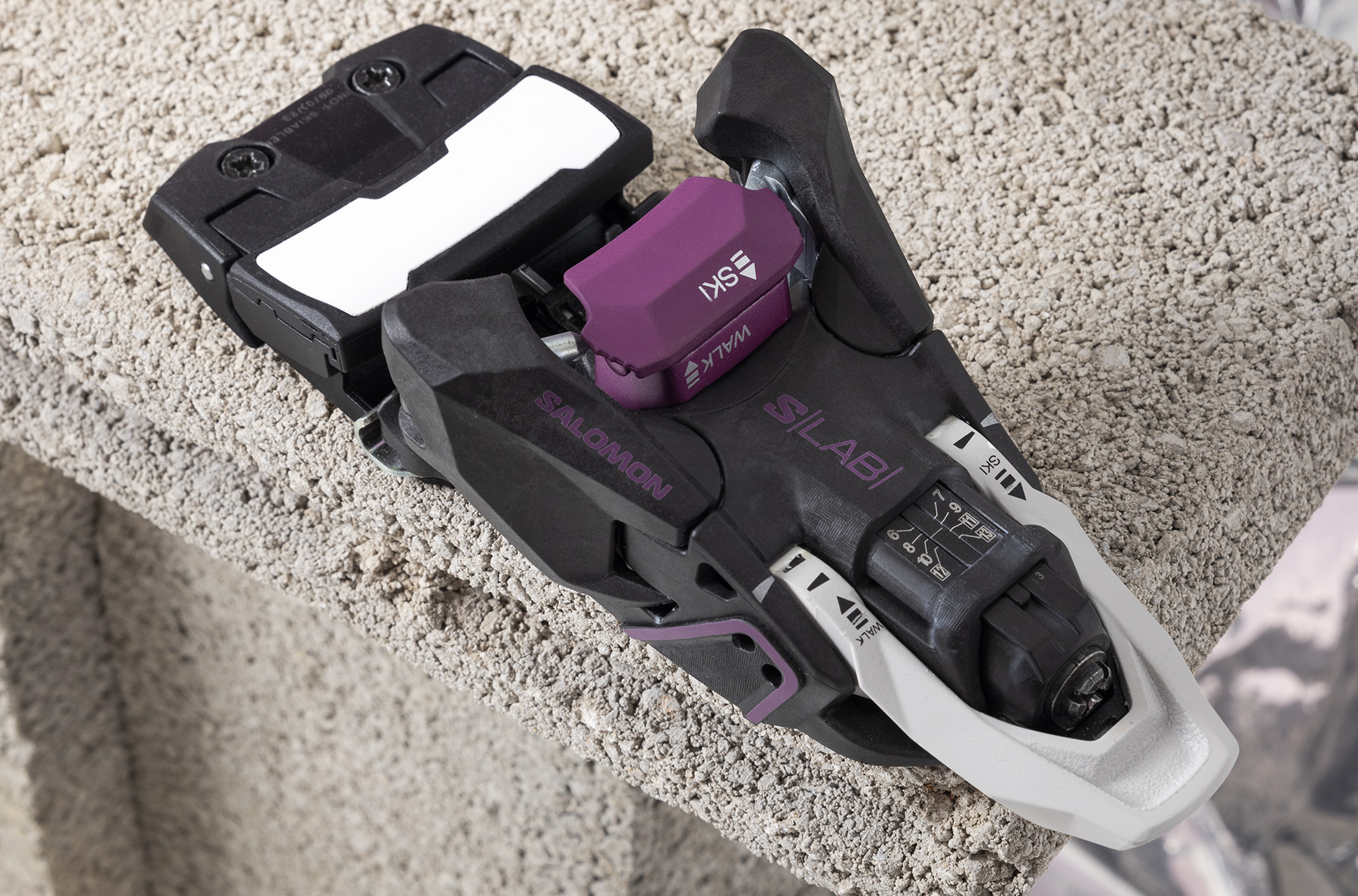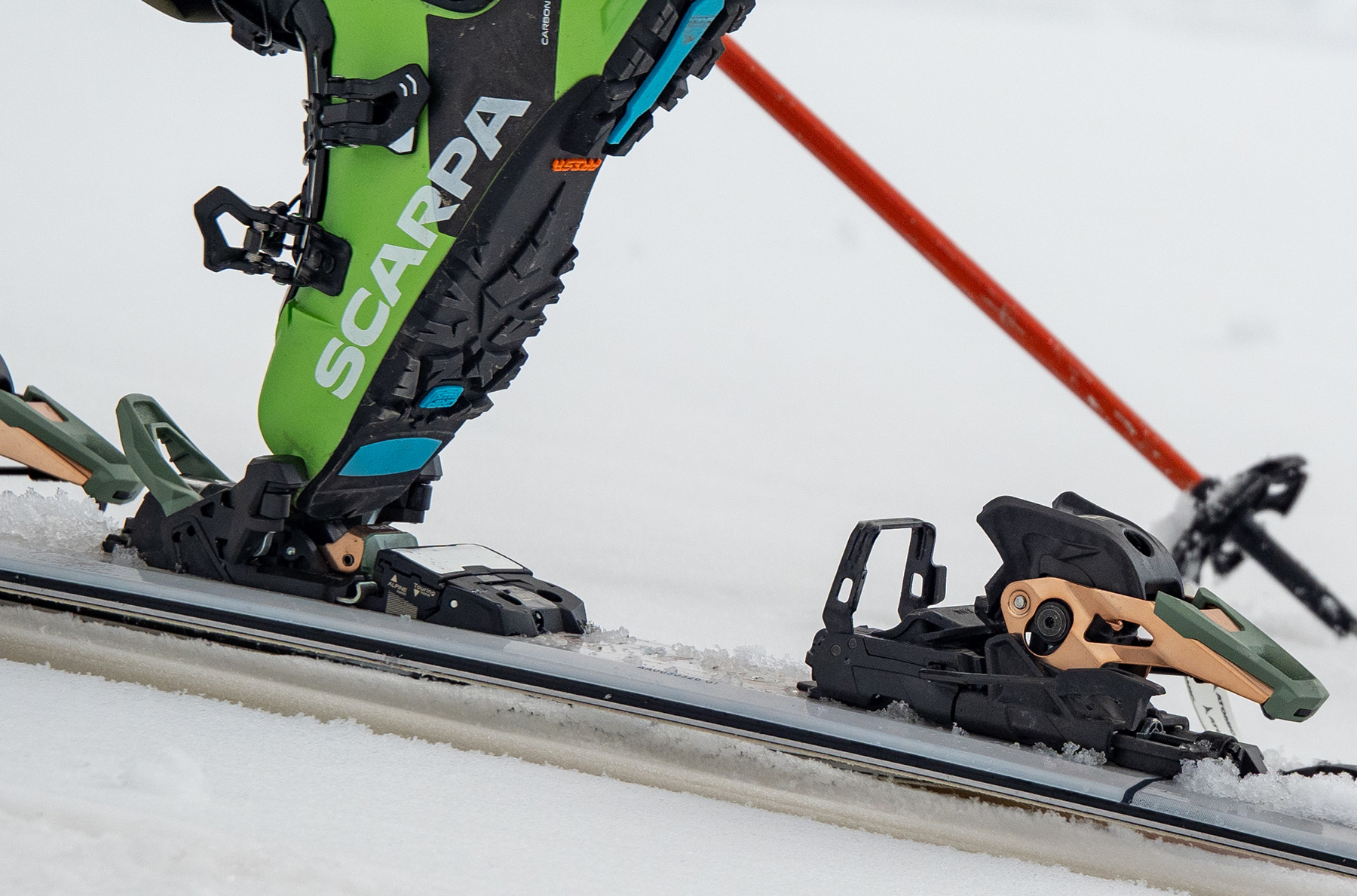

Today it was announced that the Shift binding is getting updated for the 2024-2025 season.
For reference, the original Shift binding launched in the 2018-2019 season. It made quite the splash, since it allowed users to skin uphill in pins, like a tech binding, but then ski down in a binding with the elasticity and certified DIN values of a regular alpine binding. And it did all of this while weighing about 900 grams per binding.
At the time, the only other binding that let you do that was CAST’s Freetour system, though it was heavier and only available with higher DIN values. Marker later followed with their Duke PT binding, and today, those three bindings all offer people the ability to skin uphill in pins and ski down in what is essentially an alpine binding. They also each have their own distinct pros and cons; see our AT Binding Deep Dive comparisons for more on that.
The Shift has been sold (with different colors) by three of Amer Sports’ brands: Salomon, Atomic, & Armada. It’s available in two versions; the Shift 10 covers a DIN range of 4-10, while the Shift 13 covers 6-13. The two versions are basically the same, apart from the screws used to determine their DIN / release-value ranges.
Now, basically since its release, the Shift has been very impressive from an engineering and performance perspective, but it also definitely hasn’t been without its issues. The new Shift2 binding aims to address them. It may seem very similar, visually, but the team behind the Shift2 binding has made many updates.
For starters, they’ve tweaked the Shift’s adjustable anti-friction-device, or AFD (which allows it to work with ISO-normed Alpine, GripWalk, and Touring boot soles). The previous AFD could be tricky to set up since it would often drop down a bit after the first lap or two, following your initial setup. This could create unwanted play between the boot and binding, potentially impacting release characteristics.
In Atomic’s press release about the Shift2 binding, they say “a new Micro AFD allows for a more precise fit … and the aluminum Power Block reinforces the connection for more lateral stiffness and improved power transfer.” Additionally, they claim that the Power Block insert and how it supports the AFD allows for “micrometric adjustment for an extremely precise fit with the boot interface.” Visually, one thing I can notice with the stock photos of the Shift2 binding is that there are now two screws visibly going through the AFD.

Another common qualm with the original Shift binding was about its brakes. Especially if you accidentally knocked your skis together while skinning, the Shift’s brakes could be prone to popping open while skinning uphill. According to Atomic, the Shift2 binding’s “redesigned brake lever provides more reliable locking function and eliminates unintentional release.”
Atomic’s press release also says the Shift2 binding’s “updated climbing aid adds 4mm of lift.” The wording there is a bit odd, but we assume this means they’ve added 4 mm to the original Shift binding’s existing climbing-aid height. For reference, another common complaint about the original Shift binding was that its single climbing riser (which offered a stated 10° lift) was a bit lower than some folks would have liked.
The new Shift2 binding also features larger toe wings for “improved shock resistance,” and its toe lever has been reinforced in an attempt to increase durability and reliability. (While we haven’t broken any of our Shift bindings, the original Shift’s toe lever seemed to be a weak point, based on various first-person reports we’d heard). Overall, they claim that the Shift2 binding is 30% stiffer laterally than the original Shift binding.

Same as before, the Shift2 binding will be available in two versions from Atomic, Salomon, & Armada: the Shift2 10 (DIN 4-10) and Shift2 13 (DIN 6-13). The MSRP for the Shift2 10 is $600 (USD), while the Shift2 13’s MSRP is $650.
[Editor’s Note: we initially received incorrect information regarding pricing and have since updated this post; the above prices have been confirmed by Salomon.]
As for the other specs, the Shift2 13’s stated weight is 920 grams per binding and the Shift2 10’s is 915 grams — i.e., they’ve gained about 35 grams compared to the original. They’re still available with the same 90, 100, 110, and 120 mm brake widths, as well as the same Shift-specific 100 mm and 120 mm ski crampons. The Shift2 still primarily utilizes a “carbon-infused polyamide” material for much of the binding’s construction (with aluminum & steel reinforcements), and they offer 30 mm of BSL adjustment via the heel track. We confirmed with Salomon that the Shift2 uses the same mounting / hole pattern as the original Shift binding.
We’ll be testing the new Shift2 binding soon, so BLISTER+ members should keep an eye out for Flash Reviews in the future.
Related Reviews
Now that we’ve spent time on it, you can check out below our initial Flash Review of the Shift2. BLISTER+ members and those who purchase our Digital Access Pass can read our Flash Reviews & Deep Dive comparisons, in addition to our initial First Looks and long-term Full Reviews. Get our Digital Access Pass to view all our Deep Dives and Flash Reviews, or become a BLISTER+ member today to get access to that and a LOT more, including the best worldwide Outdoor Injury Insurance, exclusive deals and discounts on skis, personalized gear recommendations from us, and much more.

Flash Review: 24/25 Salomon / Atomic Shift2 Binding
The original Shift binding was a big advancement in the touring binding category when it was first released, but it wasn’t without its flaws. The new Shift2 binding is meant to address those downsides while still letting you skin uphill in pins and get alpine-binding performance on the way down. We’ve been testing multiple pairs of the Shift2 to test those claims — here are our thoughts so far.
Blister’s Flash Reviews and Deep Dives are accessible to those who purchase one of our paid subscriptions
To get our comprehensive Deep Dives and our initial, unfiltered reports on new gear, become a member and receive many other services, deals, and discounts.
If you’re already an active member, please log in.
(If you’re already logged in and a member in good standing and seeing this message in error, please refresh this page in your browser.)

Sounds like they’ve made some good updates. An MSRP of $800-$850 is bonkers.
My jaw dropped when I read that. The originals have an MSRP of $599!
We should get a trade in credit for the OG shift! 650$ on another set which all these issues should have been addressed in the first model! Especially since Cody and all the other pros skied and tested them for years prior! It was a money grab scam! Cody you own me 650$ what I’m saying is that the shift 2 should have been the shift one! Seems that all the OG models are defective IMO! Pisses me off to be honest! That’s why I hate Amer and Salomon!
Well, I’ve got good news: we just found out that we initially received incorrect information regarding pricing. Salomon has confirmed with us that the actual MSRP for the Shift2 10 is $600 (USD), while the Shift2 13’s MSRP is $650.
That’s a bit more reasonable!
will the new stopper fit the old binding?
Any word on the mounting pattern? Did it change?
Just confirmed that it uses the same hole / mounting pattern, so no changes there.
Sounds decent, same mounting pattern? (Relevant for those of us who already bashed some toe pieces and their AFDs, and have installed inserts for replacing..
Just confirmed that it uses the same hole / mounting pattern, so no changes there.
Well that’s a relief
Green and gold really give it a “Master Chief” look.
Glad I picked up some 10’s last week for ~$440.
We just found out that we initially received incorrect information regarding pricing. Salomon has confirmed with us that the actual MSRP for the Shift2 10 is $600 (USD), while the Shift2 13’s MSRP is $650. I’ve updated the post to reflect the correct pricing.
+1 for the micro AFD. I’m curious if the added 4mm climbing aid will be enough for the local skin tracks.
Will the new riser fit in the original shift binding? Thanks!
Love the Pink!
will the new stoppers work on the old bindings?
thanks!
The main problem with the original bindings is the brakes dont deploy at enough of an angle (less than a traditional brake) which leads to runaway skis. Everyone I know with these bindings has had this issue. A big problem in steep high alpine terrain. Maybe you guys all crank your DINs so much you never lose skis. Anyhow, if Shift 2 has addressed that issue I would have replaced my old ones which I no longer trust, but it doesnt look like they have.
This has been my main problem with the shifts, too. They ski great. I’ve been diligent about checking the AFD and forward pressure setup and have never experienced pre releases. But, when they do release in wide open terrain, the brake is basically useless in halting the ski. I’ve had two runaway skis in above tree line terrain that has forced me to boot down 100+ vertical feet to retrieve them.
In fairness it’s not like there are many similar- or lighter-weight touring bindings that don’t have such brake effectiveness issues. That’s certainly true for the various iterations of ATK bindings and Tectons with which I have direct experience. If you need “resort-caliber” braking performance then you’re probably a potental Duke, CAST, or Daymaker customer.
Do you think it’s possible to retrofit the new afd to the old binding?
I want to know this too!! I had significant problems with toe wiggle on version 1. Four different ski techs across Japan and australia all reviewed.
Ended up paying $60 for new AFD and same result.
Tech ended up raising AFD so firm with boot. Seems to work although a little nervous!!
Some have no life to spend money on a nice car or house, so we don’t care if we spend 650 on a binding because me personally i’ve never had more than 5,000 dollars to my name. what else can i afford?
I would probably do what I did in 1982. Just walk up the hill and ski down regular. I’ve got enough skis, and I don’t even get to use the ones that I have very often anymore. I’d like to enjoy what I have for awhile. No 600 dollar bindings for me. Walking uphill is free, if the lifts aren’t working.
When will it be available to buy?
The press release distributed said available from Feb 2024 but so far I’ve heard that EU retailers won’t have them until October and there’s still no confirmation that southern hemisphere (NZ) will get them in time for this winter July 24. At this point it seems foolish to purchase the V1s when these updates clearly indicate the issues they’ve resolved. But still no info or sign of availability.
No comments on improving snow/ice buildup clearance on the heel mechanism, which is my number one bugbear with the Shift… have had many, many issues with unreliable full heel engagement on step-in in Ski mode, especially in deep snow or when there is not a perfectly flat, clean, sturdy surface to step in on.
Hmm – will the shift 2 brake be compatible with the an original shift if you just want to upgrade the brake? (What about upgrading the lifter?
I haven’t tried putting it on a first-gen Shift, but it appears that the new brake attaches to the heel piece in the same (or, at least, very similar) way, so there’s a chance they’d be cross-compatible. The lifters / climbing aids are attached to the brake so, at least for the original Shift brakes, the brake + lifter is sold as a single unit. I’ll see if I can get a Shift2 brake onto an original Shift and report back on that once we’re ready to post our review of the Shift2
Any update on this, have you had a chance to check compatibility between the old and new generation brakes?